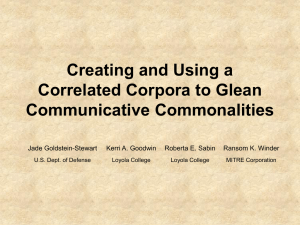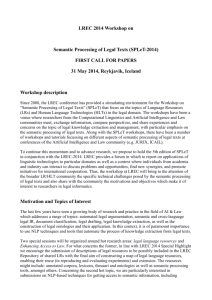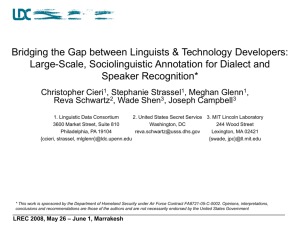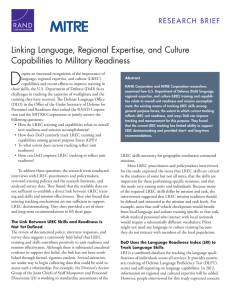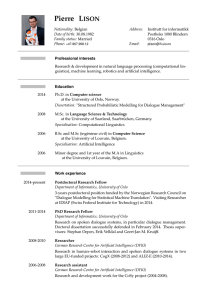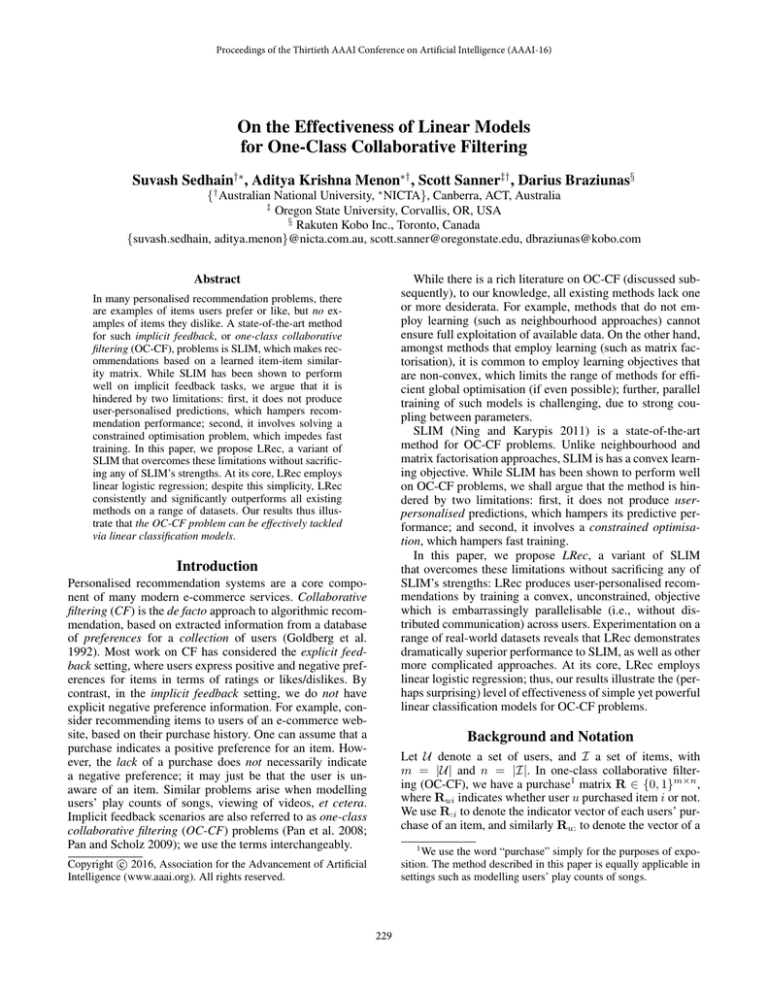
Proceedings of the Thirtieth AAAI Conference on Artificial Intelligence (AAAI-16)
On the Effectiveness of Linear Models
for One-Class Collaborative Filtering
Suvash Sedhain†∗ , Aditya Krishna Menon∗† , Scott Sanner‡† , Darius Braziunas§
{† Australian National University, ∗ NICTA}, Canberra, ACT, Australia
‡
Oregon State University, Corvallis, OR, USA
§
Rakuten Kobo Inc., Toronto, Canada
{suvash.sedhain, aditya.menon}@nicta.com.au, scott.sanner@oregonstate.edu, dbraziunas@kobo.com
While there is a rich literature on OC-CF (discussed subsequently), to our knowledge, all existing methods lack one
or more desiderata. For example, methods that do not employ learning (such as neighbourhood approaches) cannot
ensure full exploitation of available data. On the other hand,
amongst methods that employ learning (such as matrix factorisation), it is common to employ learning objectives that
are non-convex, which limits the range of methods for efficient global optimisation (if even possible); further, parallel
training of such models is challenging, due to strong coupling between parameters.
SLIM (Ning and Karypis 2011) is a state-of-the-art
method for OC-CF problems. Unlike neighbourhood and
matrix factorisation approaches, SLIM is has a convex learning objective. While SLIM has been shown to perform well
on OC-CF problems, we shall argue that the method is hindered by two limitations: first, it does not produce userpersonalised predictions, which hampers its predictive performance; and second, it involves a constrained optimisation, which hampers fast training.
In this paper, we propose LRec, a variant of SLIM
that overcomes these limitations without sacrificing any of
SLIM’s strengths: LRec produces user-personalised recommendations by training a convex, unconstrained, objective
which is embarrassingly parallelisable (i.e., without distributed communication) across users. Experimentation on a
range of real-world datasets reveals that LRec demonstrates
dramatically superior performance to SLIM, as well as other
more complicated approaches. At its core, LRec employs
linear logistic regression; thus, our results illustrate the (perhaps surprising) level of effectiveness of simple yet powerful
linear classification models for OC-CF problems.
Abstract
In many personalised recommendation problems, there
are examples of items users prefer or like, but no examples of items they dislike. A state-of-the-art method
for such implicit feedback, or one-class collaborative
filtering (OC-CF), problems is SLIM, which makes recommendations based on a learned item-item similarity matrix. While SLIM has been shown to perform
well on implicit feedback tasks, we argue that it is
hindered by two limitations: first, it does not produce
user-personalised predictions, which hampers recommendation performance; second, it involves solving a
constrained optimisation problem, which impedes fast
training. In this paper, we propose LRec, a variant of
SLIM that overcomes these limitations without sacrificing any of SLIM’s strengths. At its core, LRec employs
linear logistic regression; despite this simplicity, LRec
consistently and significantly outperforms all existing
methods on a range of datasets. Our results thus illustrate that the OC-CF problem can be effectively tackled
via linear classification models.
Introduction
Personalised recommendation systems are a core component of many modern e-commerce services. Collaborative
filtering (CF) is the de facto approach to algorithmic recommendation, based on extracted information from a database
of preferences for a collection of users (Goldberg et al.
1992). Most work on CF has considered the explicit feedback setting, where users express positive and negative preferences for items in terms of ratings or likes/dislikes. By
contrast, in the implicit feedback setting, we do not have
explicit negative preference information. For example, consider recommending items to users of an e-commerce website, based on their purchase history. One can assume that a
purchase indicates a positive preference for an item. However, the lack of a purchase does not necessarily indicate
a negative preference; it may just be that the user is unaware of an item. Similar problems arise when modelling
users’ play counts of songs, viewing of videos, et cetera.
Implicit feedback scenarios are also referred to as one-class
collaborative filtering (OC-CF) problems (Pan et al. 2008;
Pan and Scholz 2009); we use the terms interchangeably.
Background and Notation
Let U denote a set of users, and I a set of items, with
m = |U| and n = |I|. In one-class collaborative filtering (OC-CF), we have a purchase1 matrix R ∈ {0, 1}m×n ,
where Rui indicates whether user u purchased item i or not.
We use R:i to denote the indicator vector of each users’ purchase of an item, and similarly Ru: to denote the vector of a
1
We use the word “purchase” simply for the purposes of exposition. The method described in this paper is equally applicable in
settings such as modelling users’ play counts of songs.
c 2016, Association for the Advancement of Artificial
Copyright Intelligence (www.aaai.org). All rights reserved.
229
user’s preference for each item. We denote by R(u) the set
of the items purchased by user u.
The goal in OC-CF is to learn a recommender, which for
our purposes is simply a matrix R̂ ∈ Rm×n of the same size
as R. We call R̂ the recommendation matrix. As the entries
are real-valued, for each user u, we can sort the entries of
R̂u: to obtain a predicted ranking over items. We evaluate
R̂ assuming we are in the top-N recommendation scenario
(Deshpande and Karypis 2004): here, the interest is in finding R̂ such that the head of the ranked list for each user
comprises items she will enjoy.
The challenge in OC-CF is the lack of explicit negative
preference. A user not purchasing an item does not necessarily indicate a negative preference: the user may simply
be unaware of the item. Henceforth, we say that (u, i) pairs
with Rui = 1 denote “known positive preference”, while
pairs with Rui = 0 denote “unknown preference”.
We now review some existing approaches to OC-CF. We
focus on approaches that rely only on information provided in R, and thus do not discuss approaches that exploit additional information, e.g. those that exploit an exogenous network amongst users or items (Yu et al. 2014;
Sedhain et al. 2014).
Matrix factorisation
Matrix factorisation methods are the de facto approach to
collaborative filtering with explicit feedback. The basic idea
is to embed users and items into some shared latent space
(Srebro and Jaakkola 2003; Koren, Bell, and Volinsky 2009).
Formally, let J ∈ Rm×n
be some weighting matrix to be de+
fined shortly. Let : R × R → R+ be some loss function,
typically squared loss (y, ŷ) = (y − ŷ)2 . Then, matrix factorisation methods optimise
Jui · (Rui , R̂ui (θ)) + Ω(θ),
(3)
min
θ
u∈U ,i∈I
where the recommendation matrix is2
(4)
R̂(θ) = AT B
for θ = {A, B}, and the regulariser Ω(θ) is typically
λ
Ω(θ) = · (||A||2F + ||B||2F )
2
for some λ > 0. The matrices A ∈ RK×m , B ∈ RK×n
are the latent representations of users and items respectively,
and K ∈ N+ the latent dimension of the factorisation.
In standard CF applications with explicit negative feedback, one typically sets (Koren, Bell, and Volinsky 2009)
Jui = Rui > 0, so that one only considers (user, item)
pairs with known preference information. In implicit feedback problems, this is not appropriate, as one will simply learn on the known positive preferences, and thus predict R̂ui = 1 uninformatively. An alternative is to set
Jui = 1 uniformly. This treats all absent purchases as indications of a negative preference. The resulting approach is
termed PureSVD in (Cremonesi, Koren, and Turrin 2010),
and has been shown to perform surprisingly well in top-N
recommendation task for both explicit and implicit feedback
datasets (Cremonesi, Turrin, and Airoldi 2011).
As an intermediate between the two extreme weighting
schemes above, the WRMF method (Pan et al. 2008) sets
Jui to be
Jui = Rui = 0 + α · Rui > 0
(5)
where α assigns an importance weight to the observed ratings. More sophisticated weighting schemes have also been
explored. In scenarios where there are multiple observations
for each (user, item) pair, (Hu, Koren, and Volinsky 2008)
considered a logarithmic weighting of these counts.
Neighbourhood methods
There are two broad types of neighbourhood methods. The
first type is item-based neighbourhood methods, where we
produce a recommendation matrix of the form
(1)
R̂ = RSI ,
where SI ∈ R
is an item-item similarity matrix. The
second type is user-based neighbourhood methods, which
effectively operate on RT instead of R, producing a recommendation matrix of the form
(2)
R̂ = SU R
m×m
is a user-user similarity matrix. The
where SU ∈ R
intuition for both types of method is simple: observe that in
item-based methods,
Rui · Si i .
R̂ui =
n×n
i ∈I
That is, for a user u, one scores an item i as the sum of i’s
similarity to all other items that u enjoys. A similar intuition
holds for user-based methods.
Typically, one chooses the similarity matrix S∗ as a predefined function of R, such as cosine similarity (Sarwar et al.
2001; Linden, Smith, and York 2003): for item-based methods, this is given by
RT:i R:i
.
S i i =
||R:i ||2 ||R:i ||2
Other examples are the Pearson correlation, Jaccard coefficient and conditional probability (Deshpande and Karypis
2004). It is typical to sparsify S by retaining only top-k similar entries in the similarity matrix.
Recommendation performance can be quite sensitive to
the choice of S, and the choice generally depends on the
problem domain. Therefore, neighbourhood methods are unable to adapt to the characteristics of the data at hand.
Bayesian personalised ranking (BPR)
An alternate strategy to adapt matrix factorisation to the implicit feedback setting is the Bayesian Personalised Ranking (BPR) model (Rendle et al. 2009). BPR optimises a loss
over (user, item) pairs, so that the known positive preferences score at least as high as the unknown preferences:
(1, R̂ui (θ)−R̂ui (θ))+Ω(θ), (6)
min
θ
u∈U ,i∈R(u),i ∈R(u)
/
where (1, v) = log(1+e−v ) is the logistic loss, and R̂ is as
per Equation 4. Intuitively, this does not disallow high scores
for items with unknown preferences, but simply places these
scores below that of an item with a positive preference.
2
230
We omit user- and item- bias terms for brevity.
SLIM
Properties of LRec
SLIM (Ning and Karypis 2011) directly learns an itemsimilarity matrix W ∈ Rn×n via
λ
min ||R − RW||2F + ||W||2F + μ||W||1 ,
(7)
W∈C
2
where λ, μ > 0 are appropriate constants, and
(8)
C = {W ∈ Rn×n : diag(W) = 0, W ≥ 0}.
Here, || · ||1 is the elementwise 1 norm of W which encourages sparsity, and the constraint diag(W) = 0 prevents a
trivial solution of W = In×n . The nonnegativity constraint
offers interpretability, but (Levy and Jack 2013) showed that
it can be ignored without affecting performance. Given a
learned W, SLIM produces a recommendation matrix
Several observations are worth emphasising at this point.
First, training of the model is highly parallelisable across the
users, as the weights w(u) do not depend on each other. Parallelisation may thus be conducted without distributed communication. Further, the feature matrix X is identical across
all users u. Therefore, this matrix can be shared across all
such parallel executions of a per-user model, which is useful
on a multi-core architecture.
Second, the feature matrix for each model is highly
sparse: we expect that for most items, only a small fraction
of users will have purchased them. This means that the optimisation of each user’s model can be done efficiently, employing e.g. sparse matrix-vector computations. Also, when
m n, optimising the dual objective reduces training time
significantly over optimising the primal.
Third, with a large number of users, we have a highdimensional feature representation, which introduces the apparent risk of overfitting. Our use of 2 regularisation mitigates this issue. Further, observe that if we optimise the dual
objective, the effective number of parameters for each user
is simply the total number of items n, which may be considerably smaller than m.
Fourth, the use of 2 regularisation is crucial beyond its
value in preventing overfitting. Recall that for each user u’s
model, that user’s purchase history is included as a feature.
Without regularisation, then, the solution to Equation 9 is
trivial: we simply let Wuu = 0 for all u = u , and let
Wuu → +∞. However, with 2 regularisation, such a solution is penalised. What is favoured instead is a spreading of
weight across other similar users.
Fifth, the objective in Equation 9 is strictly convex. Therefore, there are no issues of local optima.
Sixth, in the model for each user, LRec treats unknown
preferences as negative examples. It appears that this falls
into the trap of suppressing preferences for items that the
user is unaware of. However, we can view the learning problem for each user as one of learning from positive and unlabelled data. (Elkan and Noto 2008) proved a surprising
fact about learning from such data, namely, that for the purposes of ranking, it suffices to simply treat the unlabelled examples as negative, and estimate class-probabilities. As we
are only interested in ranking performance for top-N recommendation, this justifies treating unknown preferences as
negative, provided we choose an in Equation 9 that is capable of estimating class-probabilities, e.g. logistic ((y, v) =
log(1 + e−yv )) or squared ((y, v) = (1 − yv)2 ) loss.
R̂(θ) = RW.
Thus, SLIM can be seen as an item-based neighbourhood
approach where the similarity matrix S is learned from data.
The LRec Model
We now describe LRec, our approach to OC-CF based on
linear classification. Define a matrix X ∈ Rn×m by
X = RT ,
and, for each u ∈ U, define a vector y(u) ∈ {±1}n by:
y(u) = 2Ru: − 1.
Then, LRec solves
(u)
(yi , Xi: w(u) ) + Ω(θ),
min
θ
(9)
u∈U i∈I
where is some convex loss function, and θ = {w(u) }u∈U .
Each w(u) ∈ Rm , and so we can equivalently think of θ =
{W} for some W ∈ Rm×m , with w(u) = W:u . Given a
learned W, LRec produces a recommendation matrix
R̂(θ) = WT R.
(10)
λ
2
2 ||W||F .
We shall
In the sequel, we will employ Ω(θ) =
also choose to be the logistic loss, (y, v) = log(1+e−yv ),
which we favour due to the existence of efficient solvers for
linear logistic regression, such as L IB L INEAR (Fan et al.
2008), and its suitability for estimating class-probabilities,
which we shall see is appropriate for OC-CF problems.
Equation 9 can be interpreted as a linear classification
model for each user u. For each such model, we have a
separate training example corresponding to each item in the
dataset. The feature vector for each item comprises the purchase history for all users, including the one in consideration3 . The label for each item is simply whether or not the
user in consideration purchased it. Each Wuu can be seen
as a weight indicating the relevance of the purchases of user
u in predicting the purchases of the user u .
The above assumes the use of a linear kernel for the underlying classification model. In principle, one could also use a
nonlinear kernel. However, we did not explore this owing to
the strong performance of linear logistic regression, and the
comparatively slower training of kernel methods.
Relation to existing methods
We now contrast LRec to existing methods for recommendation with implicit feedback. We shall argue that LRec is
the only proposed method (to our knowledge) that is learning based, with a convex objective that is efficient to train in
parallel, and which produces user-personalised predictions.
Relation to SLIM The model most closely related to
LRec is SLIM (Equation 7). To see the connection, observe
that we may rewrite SLIM as (see also (Ning and Karypis
3
This is only done for the training purchases of each user.
Therefore, there is no leakage of test purchases into the model.
231
2011, Equation 4))
(i)
(yu(i) , X(i)
min
u: w ) + Ω(W),
W∈C
Relation to neighbourhood methods As item-based
neighbourhood approaches are subsumed by SLIM, the
above advantages of LRec over SLIM apply to such methods as well. Compared to user-based neighbourhood methods, LRec uses a similarity matrix that is learned from data:
the weight matrix W learned by LRec is a user-user similarity matrix, chosen so as to optimise recommendation performance for each individual user.
i∈I u∈U
where C is as in Equation 8, (y, v) = (y − v)2 is the square
loss, and the feature matrix X and label vector y(i) is
X = R ; y(i) = R:i .
Relation to matrix factorisation Compared to matrix
factorisation approaches, LRec does not involve projection
of users and items into a shared latent space. However, we
can interpret factorisation approaches as follows. Consider
WRMF with Jui = 1 uniformly. Then, the optimal solution
for the item latent factors is clearly
LRec can thus be seen as a variant of SLIM where: (1) one
learns a user-user rather than item-item weight matrix; (2)
there are no constraints in performing the optimisation; and
(3) the target user is included when training each model. As
a result of these design choices, LRec has three main advantages over SLIM.
User-focussed modelling. We can see SLIM as learning a
separate model for each item, where in each such model we
treat each user as a training instance, represented by their
purchase history. This is in contrast to LRec, which learns a
separate model for each user. While this difference appears
trivial, it is very important in the context of recommendation.
LRec ensures that its predictions are personalised to each
user: for each user, the model attempts to produce the best
possible ranking over items. By contrast, SLIM solves a subtly different problem, namely, ensuring that for each item,
there is a good ranking over the users that would be interested in it. That is, SLIM can be seen as optimising a
ranking for a fictional average user, and thus does not produce genuinely personalised predictions. Our experiments
demonstrate that personalising the results towards each user,
as in LRec, yield significant performance improvements.
Note that there may be recommendation scenarios where
user-focussed modelling is not possible due to limited feedback. For example, a news site may wish to recommend articles to visitors without having any information about their
viewing or preference history. In these scenarios, item-based
recommendation may be superior. But in the many important
applications where users do provide sufficient amounts of
feedback, user-focussed modelling can be significantly more
accurate and useful.
Optimisation. With the choice of logistic loss, the unconstrained LRec objective (Equation 9) can be optimised
via standard logistic regression solvers. By contrast, optimisation of SLIM requires respecting the nonnegativity constraint on the weights, as well as performing 1 regularisation. The resulting optimisation is not as efficient as the unconstrained version (Levy and Jack 2013), and thus LRec
can scale to larger datasets. This is illustrated in our results,
where SLIM is unable to run on a large real-world dataset
(the Million Song Dataset), unlike LRec.
Inclusion of target user. Another subtle difference between LRec and SLIM is the definition of the constraint set
C. In SLIM, the use of diag(W) = 0 is crucial, because
otherwise as noted we can just set W = I and attain zero
loss. However, such a solution will not be optimal when using logistic loss, as in LRec. Therefore, this means that the
constraint diag(W) = 0 is unnecessary. Dropping the constraint is beneficial from the perspective of parallelisation, as
we can share the feature matrix X across multiple models.
B = (AAT + λI)−1 AR.
This means that the factorisation equally predicts
R̂ = SR,
where S = AT (AAT + λI)−1 A is a rank K matrix. (A
similar analysis was performed in (Hu, Koren, and Volinsky
2008).) Thus, we can view matrix factorisation as solving a
surrogate to
(u)
(yi , Xi: w(u) ) + Ω(W),
min
W∈C
u∈U i∈I
where C = {W ∈ Rm×m : rank(W) = K}. There are three
main advantages to LRec over such approaches.
Convexity of objective. Matrix factorisation imposes the
constraint that the weight matrix is rank K. This can be
viewed as performing reduced rank regression. While a lowrank assumption is plausible, it makes the resulting optimisation non-convex. By contrast, LRec allows S to be fullrank, and uses an 2 penalty to prevent overfitting, resulting
in a strongly convex objective.
Parallelisation w/o distributed communication. Matrix
factorisation models can be trained via alternating least
squares (ALS) (Koren, Bell, and Volinsky 2009). For a fixed
set of item latent features B, we can learn the user latent
features A by performing least squares using a design matrix X = B and, for each u ∈ U , a target vector y(u) = RTu: .
As in LRec, this operation can be parallelised across users.
However, when it comes to learning the item latent features,
all distributed nodes must send their estimates of A to a central source. As ALS typically requires several such alternation iterations, this communication may become expensive.
In LRec, such distributed communication is not required:
both learning and recommendation for all users can be done
completely independently.
Richer model class. Matrix factorisation considers weight
matrices W that are low-rank. This might induce underfitting if one does not choose sufficiently many latent features
K in the factorisation. As LRec does not constrain W explicitly, but instead merely penalises its Frobenius norm, it
employs a richer model class. As we shall see in our experiments, this endows LRec with better predictive performance.
232
Table 1: Summary of datasets used in evaluation.
Incorporating side-information
As a final comment, we note that it is easy to incorporate
any side-information in the form of feature vectors for users
and items into LRec. Suppose each item has a feature vector
v ∈ Rd . Let V ∈ Rn×d denote the matrix of features for all
items. Then, we can use exactly the same core LRec model
as Equation 9, but change the feature representation to
X = RT V ∈ Rn×(m+d) .
m
n
|Rui > 0|
M L 1M
KOBO
L AST FM
M SD
6,038
38,868
992
1,019,318
3,533
170,394
107,398
384,546
575,281
89,815
821,011
48,373,586
Evaluation protocol
The learned weights are now W ∈ Rm×(m+d) , so that for
each user we additionally learn affinities to the item features.
For the M L 1M and L AST FM datasets, we estimate performance based on 10 random train-test splits, similar to (Pan et
al. 2008; Johnson 2014). For each split, we remove a random
20% subset of all (user, item) pairs (regardless of whether
purchased or not), and place them in the test set. We then
make predictions using the training set, and evaluate the performance against the test set. We report the mean test split
performance, along with standard errors corresponding to
95% confidence intervals. To evaluate performance, we report Precision@20 (averaged across all test fold users), and
mean average precision (mAP@100).
For KOBO, we followed the above except using temporally divided train and test splits. In each split, the training
set includes all purchases prior to a specific date, and the test
set all purchases in the following week.
For M SD, we use the provided training set to learn all
models. We evaluate performance on 10 random subsets of
the provided test set. In each such random subset, we pick
500 random test users to evaluate performance on.
Experimental Evaluation
We now report experimental results of LRec against competing methods on a number of implicit feedback datasets.
Methods compared
We compared LRec trained with the logistic loss (Equation
9) to a number of baselines:
• Recommending to each user the most popular items
they have not purchased (Popularity).
• User- and item-based nearest neighbour (U-KNN and
I-KNN), using the best performing of the cosine similarity and Jaccard coefficient to define S.
• PureSVD of (Cremonesi, Koren, and Turrin 2010).
• Weighted matrix factorisation (WRMF), Equation 3.
• Logistic matrix factorisation (LogisticMF), as per
Equation 3 with the weights Jui = Rui > 0, and
being the logistic loss.
• Bayesian Personalised Ranking (BPR), Equation 6.
• SLIM, as per Equation 7. For computational convenience, we used the SGDReg variant (Levy and Jack
2013), which removes the nonnegativity constraint.
• Two variants of LRec, one which uses square rather
than logistic loss (LRec+Sq), and one which additionally employs 1 regularisation and nonnegativity of
weights (LRec+Sq+1 +NN). The weight constraints in
the latter approach are as employed by SLIM.
For the neighbourhood methods, we tuned the neighbourhood size from {10, 20, 40, 80, 120, 160, n/m}. For
methods relying on a latent dimension K, we tuned
this from {10, 20, 40, 80, 120, 160}. For methods relying on 2 regularisation, we tuned this from λ ∈
{1000, 100, 10, 1, 0.1, 0.01, 0.001, 0.0001}. For WRMF, the
weight α (Equation 5) was tuned from {1, 5, 10, 20, 40, 80}.
Tables of Results
The experimental results (Table 2) indicate the following:
• LRec and LRec+Sq consistently outperform all existing methods by a statistically significant margin. In
terms of the mAP@100 score, the % improvement over
the next best existing method is 3.4% on M L 1M, 7.7%
on KOBO, 11.5% on L AST FM, and 14.2% on M SD.
• LRec+Sq consistently outperforms LRec+Sq+1 +NN.
This suggests that the constraints on W and 1 regularisation (as imposed by SLIM) are harmful for retrieval.
• On all but the M L 1M dataset, the number of (test)
users is significantly fewer than the number of items.
Therefore, methods that are item-focussed tend to
strongly underperform. For example, on the L AST FM
dataset, the otherwise competitive SLIM method performs much worse than all other methods.
• Amongst the matrix factorisation methods, WRMF performs the best in all datasets, and is competitive with
the neighbourhood methods. The better performance
of LRec suggests that the rank restriction of WRMF
makes the model under fit to the data.
• BPR generally underperforms, likely since it optimises
AUC that does not target the head of the ranked list.
• The scale of M SD is challenging: several methods, including WRMF and SLIM, did not finish running in
a day5 . Compared to similarly scalable neighbourhood
methods, LRec’s performance is significantly superior.
Datasets used
We evaluated all methods on four datasets: (a) M L 1M,
the MovieLens 1M dataset, (b) KOBO, an e-book purchase
dataset from Rakuten Kobo Inc.4 , (c) L AST FM, a song play
count dataset from LastFM (Celma 2008), and (d) M SD,
the Million Song dataset (Bertin-Mahieux et al. 2011). For
M L 1M, we binarised ratings of 4 and 5 to be positive preferences. For the L AST FM and M SD datasets, we binarised
by setting all nonzero playcounts to 1. Table 1 summarises
statistics of these datasets.
4
Dataset
5
http://www.kobo.com
233
LRec was executed in a parallel environment, whereas the
Near cold-start recommendation
.0
4%
15
[247, 480]
[481, 590]
1.
8%
0.
[76, 246]
7%
0%
5
4.
4.
8%
8.
10
[591, 722] [723, 1144] [1145, 1571]
Avg popularity of training set movies
Figure 2: Improvement in Prec@20 of LRec over WRMF
for users with varying average popularity of their training
set movies, M L 1M dataset.
23
.1
%
Conclusion
20
5%
We propose LRec, a variant of SLIM for OC-CF problems
based on linear classifiers, where we identify and address
key limitations of SLIM. LRec has several desirable properties such as being learning-based, yielding a convex optimisation objective, producing user-personalised recommendations, and being embarrassingly parallelisable. Experiments
on a range of datasets show that LRec significantly outperforms existing state-of-the-art methods for OC-CF.
An important avenue for future work is exploring techniques to further scale LRec and reduce its memory burden
when dealing with a large number of users.
7%
4.
5.
4.
9%
5%
1%
8.
10
[7, 21]
[22, 46]
[47, 98]
[99, 400] [401, 1141]
2.
% improvement in Prec@20
20
0
30
0
25
20
% improvement in Prec@20
Table 2 summarises retrieval performance across all users.
However, different users will have rated different numbers of
items. It is of interest to see how LRec compares to baselines
as a function of the numbers of ratings provided by a user.
To do this, we segment users on the M L 1M dataset based on
the 1%, 25%, 50%, 75% and 99% quantiles of the number
of training ratings. For each segment, we then plot the %
improvement in terms of Prec@20 of LRec over WRMF.
Figure 1 shows the improvements of LRec across these
segments. We see that, reassuringly, LRec is significantly
superior to WRMF over all user segments. Of interest is that
we see dramatic improvements in Prec@20 for LRec over
WRMF for users with a small number (1 – 6) of ratings.
This shows that LRec is especially useful in near cold-start
recommendation scenarios.
%
a movie is simply the number of training purchases of the
movie. We see that for non-mainstream users, LRec achieves
significant improvement over WRMF. This illustrates that
LRec captures user preferences at a finer granularity.
[1, 6]
# of user ratings
Figure 1: Improvement in Prec@20 of LRec over WRMF
for varying number of training ratings, M L 1M dataset.
Case-study
Acknowledgments
We now study the qualitative impact of the above performance gains. On the M L 1M dataset, we compare the top 10
recommendations generated by LRec and WRMF for a user
with relatively few training ratings (16). Table 3 shows a selection of this user’s preferred movies on the training set,
as well as the resulting recommendations. We see that the
user’s training preferences are towards sci-fi movies, which
are picked up by both WRMF and LRec. However, we see
that more specifically, the user enjoys “B-grade” Hollywood
sci-fi movies, often themed on “alien invasion”, with movies
such as “It Came from Beneath the Sea”. This is not picked
up by WRMF, which recommends more “cerebral” sci-fi
movies such as “2001”. By contrast, LRec successfully captures all three preferred movies in the user’s test set.
The above illustrates a general phenomenon: LRec can
produce accurate recommendations for non-mainstream
users, i.e. users whose preferences are for items that are
not popular. As an analogue to Figure 1, Figure 2 shows the
% improvement in Prec@20 scores for LRec over WRMF,
where users are segmented according to the average popularity of their training set movies. Here, the popularity of
NICTA is funded by the Australian Government through
the Department of Communications and the Australian Research Council through the ICT Centre of Excellence Program. The authors thank the anonymous reviewers for their
valuable feedback.
References
Bertin-Mahieux, T.; Ellis, D. P.; Whitman, B.; and Lamere,
P. 2011. The million song dataset. In ISMIR’ 11.
Celma, Ò. 2008. Music Recommendation and Discovery
in the Long Tail. Ph.D. Dissertation, Universitat Pompeu
Fabra.
Cremonesi, P.; Koren, Y.; and Turrin, R. 2010. Performance
of recommender algorithms on top-n recommendation tasks.
In RecSys’10.
Cremonesi, P.; Turrin, R.; and Airoldi, F. 2011. Hybrid
algorithms for recommending new items. In HetRec ’11,
33–40. New York, NY, USA: ACM.
Deshpande, M., and Karypis, G. 2004. Item-based top-n
recommendation algorithms. ACM Transactions on Information Systems 22.
Elkan, C., and Noto, K. 2008. Learning classifiers from only
positive and unlabeled data. In KDD ’08.
other baselines were run on single machines. Hence, it is not meaningful to directly compare runtimes of LRec and other methods.
But the ability of LRec to be parallelised with ease accounts for its
ability to scale to datasets such as M SD.
234
Table 2: Results of OC-CF methods on benchmark datasets. “DNF” indicates a method did not finish running in 24 hours.
mAP@100
prec@20
M L 1M
L AST FM
KOBO
M SD
M L 1M
L AST FM
KOBO
M SD
Popularity
0.069 ± 0.001
0.086 ± 0.001
0.036 ± 0.015
0.018 ± 0.006
0.111 ± 0.001
0.272 ± 0.002
0.010 ± 0.005
0.024 ± 0.002
U-KNN
I-KNN
0.156 ± 0.001
0.148 ± 0.002
0.116 ± 0.029
0.108 ± 0.008
0.182 ± 0.001
0.397 ± 0.002
0.017 ± 0.003
0.091 ± 0.007
0.147 ± 0.001
0.168 ± 0.002
0.112 ± 0.010
0.155 ± 0.011
0.183 ± 0.001
0.433 ± 0.001
0.016 ± 0.002
0.148 ± 0.016
PureSVD
WRMF
LogisticMF
0.161 ± 0.001
0.168 ± 0.002
0.170 ± 0.001
0.183 ± 0.001
0.090 ± 0.009
0.097 ± 0.022
DNF
DNF
0.193 ± 0.002
0.198 ± 0.002
0.444 ± 0.002
0.459 ± 0.002
0.010 ± 0.009
0.012 ± 0.004
DNF
DNF
0.068 ± 0.002
0.085 ± 0.001
0.042 ± 0.021
DNF
0.110 ± 0.001
0.271 ± 0.001
0.010 ± 0.003
DNF
BPR
0.161 ± 0.001
0.150 ± 0.002
0.062 ± 0.025
DNF
0.193 ± 0.002
0.389 ± 0.012
0.014 ± 0.003
DNF
SLIM
0.175 ± 0.001
0.031 ± 0.003
0.109 ± 0.018
DNF
0.201 ± 0.001
0.032 ± 0.004
0.016 ± 0.002
DNF
LRec+Sq+1 +NN
LRec+Sq
0.165 ± 0.003
0.203 ± 0.001
0.125 ± 0.013
0.148 ± 0.020
0.198 ± 0.002
0.480 ± 0.001
0.018 ± 0.001
0.145 ± 0.018
0.176 ± 0.001
0.204 ± 0.001
0.128 ± 0.017
0.153 ± 0.012
0.203 ± 0.001
0.494 ± 0.004
0.019 ± 0.002
0.152 ± 0.015
LRec
0.181 ± 0.001
0.183 ± 0.001
0.125 ± 0.020
0.177 ± 0.013
0.208 ± 0.001
0.453 ± 0.002
0.018 ± 0.002
0.164 ± 0.016
Table 3: Subset of 16 preferred training set movies for a candidate user, and resulting top 10 recommendations on M L 1M
dataset. Bolded entries are actually enjoyed by user on test set, which is shown as the last column.
Preferred training movies
WRMF recommendations
LRec recommendations
Preferred test movies
• Day the Earth Stood Still, The
• Forbidden Planet
• Planet of the Apes
• Them!
• Blob, The
• Thing, The
• Godzilla (Gojira)
• Them!
• Kronos
• Night of the Living Dead
• Star Trek: The Wrath of Khan
• Blob, The
• 20,000 Leagues Under the Sea
• It Came from Outer Space
• Tarantula
• Thing From Another World, The
• Fly, The
• Soylent Green
• War of the Worlds, The
• Alien
• Village of the Damned
• It Came from Beneath the Sea
• Invasion of the Body Snatchers
• Earth Vs. the Flying Saucers
• Dark City
• Star Trek IV: The Voyage Home
• 2001: A Space Odyssey
• Metropolis
• Quatermass and the Pit
• It Came from Outer Space
• It Conquered the World
• Gattaca
• Plan 9 from Outer Space
Fan, R.-E.; Chang, K.-W.; Hsieh, C.-J.; Wang, X.-R.; and
Lin, C.-J. 2008. LIBLINEAR: A library for large linear
classification. Journal of Machine Learning Research 9.
Goldberg, D.; Nichols, D.; Oki, B. M.; and Terry, D.
1992. Using collaborative filtering to weave an information
tapestry. Communications of the ACM 35.
Hu, Y.; Koren, Y.; and Volinsky, C. 2008. Collaborative
filtering for implicit feedback datasets. In ICDM ’08. IEEE
Computer Society.
Johnson, C. C. 2014. Logistic matrix factorization for implicit feedback data. In NIPS’14 2014 Workshop on Distributed Machine Learning and Matrix Computations.
Koren, Y.; Bell, R.; and Volinsky, C. 2009. Matrix factorization techniques for recommender systems. Computer 42.
Levy, M., and Jack, K. 2013. Efficient top-n recommendation by linear regression. In RecSys’13 Large Scale Recommender Systems Workshop.
Linden, G.; Smith, B.; and York, J. 2003. Amazon.com recommendations: Item-to-item collaborative filtering. IEEE
Internet Computing 7.
Ning, X., and Karypis, G. 2011. SLIM: Sparse linear methods for top-n recommender systems. In ICDM’11. IEEE.
Pan, R., and Scholz, M. 2009. Mind the gaps: Weighting the
unknown in large-scale one-class collaborative filtering. In
KDD ’09.
Pan, R.; Zhou, Y.; Cao, B.; Liu, N. N.; Lukose, R.; Scholz,
M.; and Yang, Q. 2008. One-class collaborative filtering. In
ICDM’08.
Rendle, S.; Freudenthaler, C.; Gantner, Z.; and Lars, S.-T.
2009. BPR: Bayesian personalized ranking from implicit
feedback. In Uncertainty in Artificial Intelligence (UAI).
Sarwar, B.; Karypis, G.; Konstan, J.; and Riedl, J. 2001.
Item-based collaborative filtering recommendation algorithms. In WWW ’01.
Sedhain, S.; Sanner, S.; Braziunas, D.; Xie, L.; and Christensen, J. 2014. Social collaborative filtering for cold-start
recommendations. In RecSys’14.
Srebro, N., and Jaakkola, T. 2003. Weighted low-rank approximations. In ICML.
Yu, X.; Ren, X.; Sun, Y.; Gu, Q.; Sturt, B.; Khandelwal, U.;
Norick, B.; and Han, J. 2014. Personalized entity recommendation: A heterogeneous information network approach.
In WSDM’14.
235

